Streamlining your invoicing system into an easy-to-manage process will make a huge difference

How to organize and manage your invoicing system. Source: pixabay.com
Even though invoicing is a vital part of any business practice, it’s just one of those tasks that can get put to the bottom of the pile. As it’s such a crucial aspect of running your business, however, it’s time to organize your system in a way that works and is manageable for the long term.
So where to start? Before you completely transform what you do, take a look at the process you have now and identify where you tend to trip up and which parts you feel work well.
Streamlining your invoicing system into an easy-to-manage process will make a huge difference, so let’s get started with our top invoicing tips.
Step away from the spreadsheets
No matter the size of your company, managing multiple spreadsheets can become messy and confusing. Now’s the time to take the plunge and switch to an invoicing system. Having a cloud-based system will mean everything is saved online and your invoices can all be created, emailed and saved electronically. Invoicing systems come with a range of features that will help to make several processes more efficient.
Once your system is set up, you’ll have to input your customer information so everything is stored. Another positive is that if you have a standard hourly rate, you can input this and your total bill can be calculated automatically.
Design your invoice

Make sure your invoice has all the key information required. Source: unsplash.com
Professionalism is a given in any line of work – so your invoice shouldn’t be any different. Make sure your invoice has all the key information required (branding, business details, terms of payment including the due date, invoice number, details of products or services) plus a message of thanks.
Keep track of the details
When you deal with invoicing clients and receiving payments, it’s good practice, and often crucial to keep on top of your records. Time tracking tools provide proof of the time spent on a project or piece of work.
Keeping on top of things isn’t just providing proof to your client, though, you will also need to safely file contracts and have a regular system in place to check if payments have been made.
Revisit your policies and have a strategy ready

It’s always important to have a clear payment policy. Source: pixabay.com
It’s always important to have a clear payment policy. If you don’t currently have one, now’s the time to create one and share it with your clients so they are aware of what’s expected. If you have a policy but haven’t checked it for a while, revisit it and ensure it still fits with what you expect of your clients, and update it where necessary.
It’s also crucial for both your finances and your sanity to have a go-to strategy to ensure your clients pay on time. Whether that’s highlighting a late payment fee, or even incentives for early payments – whatever suits your brand and style and something you feel comfortable with.
Be considerate
Remember, that if this new process changes your current invoicing system, some of your long-standing clients may not appreciate certain adjustments. This might include receiving invoices electronically when they’re used to receiving them by post. This isn’t too much of a problem as you can print from your invoicing system and still post it out to them. So don’t throw out your printer just yet, have a stash of ink cartridges, paper and envelopes ready to go.
Follow these simple steps to streamlining your processes and you’ll ensure you have a well oiled and efficient invoicing machine.
SEE ALSO:









